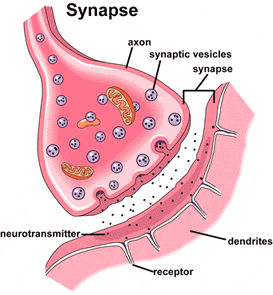The nervous system is the part something that coordinates its actions by transmitting signals to and from different parts of its body. your nervous system triggers involuntary responses, like an increase in heart rate and blood flow to your muscles, intended to help you cope with danger.
Dendrites: In order for neurons to become active, they have to receive action potentials or other stimuli. Dendrites are the structures on the neuron that receive messages. These messages that the dendrites receive come in inhibitory and excitatory forms. Excitatory stimulates AP on receiving neutron and inhibitory represses AP on receiving neutron
Nucleus: The main portion of the cell called the Soma (Cell body) contains the nucleus. The nucleus contains the genetic material in the form of chromosomes. The nucleus also contains energy for the neutron.
Cell body: The cell body contains the nucleus. The cell body connects to the dendrites, which bring information to the neuron, and the axon, which sends information to other neurons.
Axon: The axon is the long projection of the neuron, in vertebrates, that typically conducts electrical impulses known as action potentials, away from the nerve cell body.
terminal branches: The terminal branches of the axon forms junction with other cells.
An action potential is a short electric charge that travels down the axon which is caused by the movement of positive ions in and out of the axon. As an action potential or nerve impulse travels down an axon there is a change in polarity across the membrane of the axon.
A synapse is a gap between two cells. At the synaptic terminal, an electrical impulse will trigger the migration of vesicles containing neurotransmitters toward the presynaptic membrane. The vesicle membrane will fuse with the presynaptic membrane releasing the neurotransmitters into the synaptic cleft. The electrical signals carried by neurons are passed on to other neurons at the synapses. The signal may be directly transferred at electrical synapses or, if there is no physical link between adjacent neurons, the signal is carried across the gap by chemicals called neurotransmitters.
The synapse consists of three elements: The presynaptic membrane which is formed by the terminal button of an axon, the postsynaptic membrane which is composed of a segment of dendrite or cell body, and the space between these two structures which is called the synaptic cleft.
Presynaptic membrane: This is the membrane that receives a signal from the presynaptic cell and responds by depolarization or hyper-polarization.
Postsynaptic membranes: This is the membrane that receives the signal from the presynaptic membrane. After neurotransmitters interact with receptor proteins, this causes ionic channels on the membrane to either open or close
Synaptic cleft: Synaptic vesicles are released into the synaptic cleft by exocytosis.

